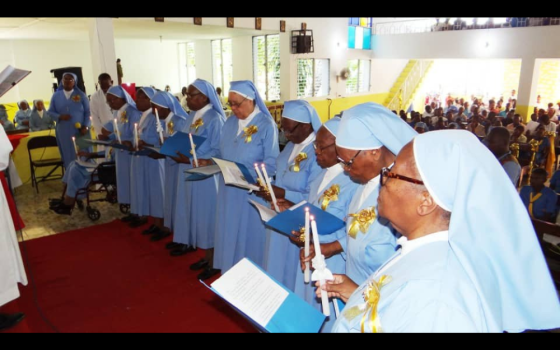United Auto Workers President Shawn Fain addresses the audience during a rally in support of striking UAW members in Detroit Sept. 15, 2023. The labor union's strike against the "Big Three" car producers -- Ford, General Motors and Stellantis -- came to an end Oct. 30 after the automakers and the unuon reached tentative agreements. (OSV News photo/Rebecca Cook, Reuters)
The United Auto Workers labor strike against the "Big Three" car producers -- Ford, General Motors and Stellantis, whose 14 automotive brands include Chrysler, Dodge, and Jeep -- has ended with a series of contracts experts say emphasizes the importance of unions in Catholic social teaching, especially for achieving family wages through collective action.
"This is the way the economy should work," said Daniel Graff, director of the Higgins Labor Program at the University of Notre Dame's Center for Social Concerns, "when workers get to say what they need, and employers respond with what they can do, and you come to an agreement."
Union contracts for 150,000 UAW members at the Big Three expired Sept. 14. Nearly seven weeks of successive strikes -- the most extended auto workers' walkout in 25 years -- followed.
For the first time in U.S. history, the UAW struck simultaneously against each of the major auto manufacturers, utilizing a targeted strategy of tactical strike locations, as opposed to traditional blanket strikes.
"All three of the Big Three now have a tentative agreement with the UAW," the labor union announced in an Oct. 30 statement. "All three agreements break records and better unite our union."
The General Motors agreement -- reached Oct. 30 -- "grants 25% in base wage increases through April 2028, and will cumulatively raise the top wage by 33% compounded with estimated COLA [cost-of-living adjustment] to over $42 an hour. The starting wage will increase by 70% compounded with estimated COLA, to over $30 an hour," said the UAW.
Wage tiers were ended, and GM agreed to make five payments of $500 to retirees and surviving spouses, "the first such payments in over 15 years," according to the UAW. Other gains include cost-of-living allowances; wage progression; retirement improvements; and an historic right to strike over plant closures -- a first for the union.
Ford's Oct. 25 agreement "grants 25% in base wage increases through April 2028, and will cumulatively raise the top wage by over 30% to more than $40 an hour, and raise the starting wage by 68%, to over $28 an hour," according to a UAW statement. "The lowest-paid workers at Ford will see a raise of more than 150% over the life of the agreement, with some workers receiving an immediate 85% increase immediately upon ratification," it said.
The deal with Stellantis -- announced Oct. 28 -- "includes gains valued at more than four times the gains from the union's 2019 contract. It provides more in base wage increases than Stellantis workers have received in the past 22 years," the UAW said.
Stellantis also has committed to adding 5,000 jobs. The union said that before the strike, Stellantis wanted to cut 5,000 jobs; and underscored this development as a victory for the "American working class" and the "American dream."
Other advances for both the Ford and Stellantis contracts are similar to the GM contract, with the addition for Stellantis workers of "a right to strike over product and investment commitments" -- another first for the union.
UAW membership is voting whether or not to ratify the agreements in the coming days.
"These settlements are a testament to collective bargaining as a practice, and as an ideal to facilitate workers having a voice in the terms of their employment," Graff told OSV News. "In an era where it's really hard to unionize a workplace if the employer doesn't want it -- and Starbucks is the prime example; over 300 stores unionized, but no contracts yet -- it's refreshing," he said. "These contracts seem like a win-win in distributing the spoils of the auto sales over the last few years."
Ford, General Motors and Stellantis made a combined $21 billion in profits during the first six months of 2023, and North American profits of a quarter-trillion dollars in the last 10 years.
"Nobody was crying any crocodile tears back in 2008 [or] 2009," when the auto industry was in crisis, said Fr. Sinclair Oubre, the spiritual moderator of the Catholic Labor Network and pastor of St. Francis of Assisi Catholic Church in Orange, Texas. "The expectation was that the UAW was going to make major concessions to keep these industries going. And when it came time to make that up again, it was like, 'No,' " he added.
U.S. President Joe Biden praised the new deals, saying Oct. 30, "They have reached a historic agreement"-- one that will "reward auto workers who gave up much to keep the industry working and going during the global financial crisis more than a decade ago."
"What has happened now," Oubre observed, "is that the power has shifted. Certainly the change in the face of the National Labor Relations Board and the Department of Labor is much more open to union organizing drives. And the decisions of the National Labor Relations Board are going to be probably a little bit less hostile to the workers."
The Biden administration has been widely regarded as more favorable to organized labor than previous administrations. Biden's Sept. 26 visit to UAW strikers in Michigan marked the first time a sitting U.S. president has walked a union picket line.
"A big challenge for organized labor after this is maintaining the momentum," said Kevin Ahern, professor of religious studies and the director of the Dorothy Day Center for the Study and Promotion of Social Catholicism at Manhattan College in Riverdale, New York.
Advertisement
"This is something where I think that the faith tradition can really help," Ahern said, "in both reminding workers of their fundamental rights, and also the responsibility to organize for themselves, their families and other members of the community -- and by also giving them a space to find community and to sustain that with faith. ... It shows from the perspective of Catholic social teaching the value of labor unions in our economy and in our community, to preserve the common good."
The Catholic Church has an extensive history of teaching and actions supporting the rights of workers and organized labor.
"There is no union without workers, and there are no free workers without a union," Pope Francis told members of the Italian General Confederation of Labor in December 2022.
While strike actions can have economic impacts -- the UAW's walkouts caused temporary car shortages and analyst predictions of higher car prices followed its current victory -- the Catholic Church has supported their necessity.
St. John Paul II in his 1981 encyclical "Laborem Exercens" taught labor strikes are "recognized by Catholic social teaching as legitimate in the proper conditions and within just limits. ... Workers should be assured the right to strike."
The U.S. Conference of Catholic Bishops' 1986 pastoral letter "Economic Justice for All" teaches, "Unions may also legitimately resort to strikes where this is the only available means to the justice owed workers."
Ahern explained, "Corporations with lawyers have time on their side. ... Workers on the picket line have a lot of pressures to return back to work, especially if they're hourly wage earners. And so, the more a company can delay -- whether it's an individual campaign or over time -- that really is detrimental to the struggle of the individual workers who are trying to organize."
The first half of 2023 witnessed a sharp rise in labor union activity, with strike actions in multiple sectors -- including media, parcel delivery, aerospace, auto and steel production, retail, hospitality and health care. Preliminary U.S. Bureau of Labor Statistics data indicate some 334,000 American workers have participated in work stoppages through September of this year.
While it's unclear if what has been called the "hot labor summer" will transition to an equally warm labor fall with additional union organizing or strikes, predictions already abound that the unprecedented labor gains will reverberate in other sectors.
On Nov. 1, Toyota announced it would be raising the wages of its nonunionized factory workers, a move largely seen as preemptive given the UAW's expected effort to unionize Toyota plants.
"Management in the auto industries know they can't just bring in replacement workers," Oubre said. "These are skilled jobs. Probably more skilled than they've ever been."
Tesla -- whose CEO Elon Musk has famously resisted attempts to unionize Tesla's electric vehicle factories -- will undoubtedly be among the UAW's next objectives, as well as the other EV factories and industry partnerships that manufacture the batteries to power them.
According to the U.S. Bureau of Labor Statistics, the union membership rate -- the percentage of wage and salary workers who belong to unions -- was 10.1% in 2022, down from 10.3% in 2021.
Nonetheless, the AFL-CIO found in a recent poll that more than two-thirds of Americans support labor unions, including majorities of Republicans and Independents; and among people younger than 30, 88% expressed solidarity.
That swell of positive public opinion could perhaps help propel a renewed union movement.
"In past moments in American labor history," Graff noted, "there has been an infectious quality to labor organizing."
UAW statements appear to reflect an emboldened future outlook.
"When we return to the bargaining table in 2028 it won't just be with the Big Three, but with the Big Five or Big Six," UAW president Shawn Fain said. "Nonunion auto workers are not the enemy. Those are our future union family. We're going to organize nonunion auto workers everywhere. Together we're going to stand up and take on corporate greed."





